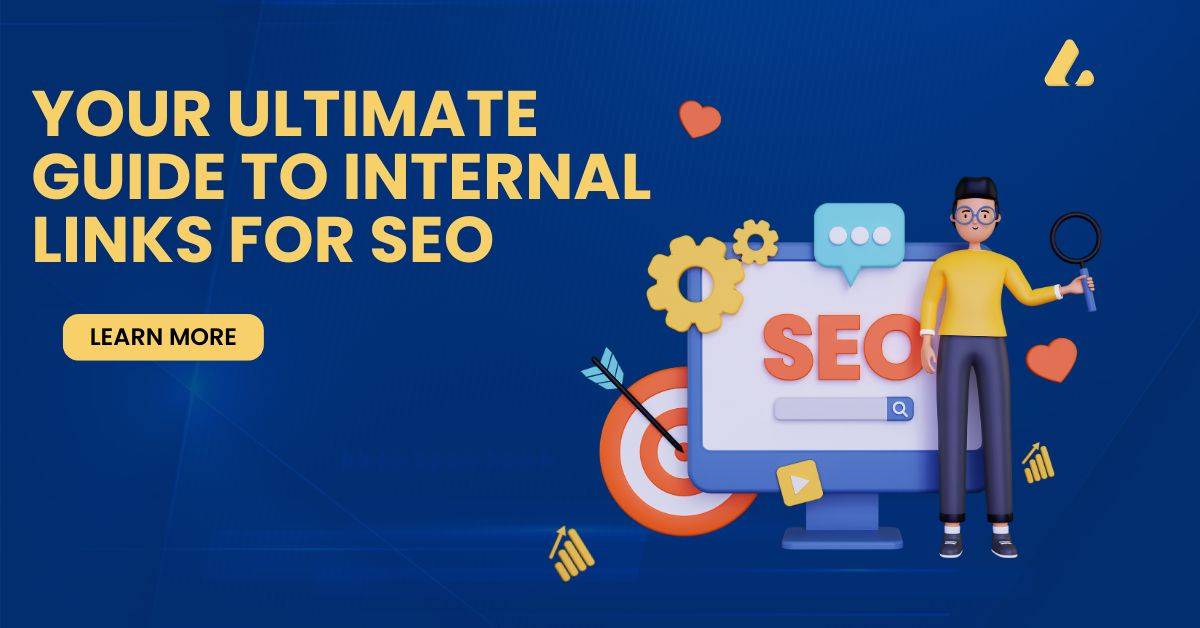Welcome to our in-depth guide on SEO internal linking! This is the right place to rank more organic keywords, increase organic traffic, and attract more visitors. Internal linking in SEO is often underestimated but can cause a huge difference in how your site performs. Here’s everything you need to know about internal links and how they should be used effectively. Let’s get started!
What are Internal Links, and Why Are They Important?
Internal links are hyperlinks that join one page of a website with another page within the same domain. They are vital for search engine optimization (SEO) and user experience since they help search engines understand a site’s structure, distribute page authority, and keep users engaged through easy navigation between related content.
Effective internal linking improves crawl ability, enhances rankings, and boosts user retention by enabling visitors to find useful information easily and stay longer at your site, increasing their engagement on-site.
Difference Between Internal and External Links
Internal links on a website are important because they facilitate page navigation and enhance the site’s authority. On the other hand, external links link your pages to other domains that provide further resources and credibility.
With internal links, search engines can understand how your site is organized, while linking to external web pages can boost the popularity ranking of your own page. Both these varieties are fundamental for molding SEO strategy and improving user experience.
Site Navigation Improvement:
A website must have internal links to guide users to other relevant content within the same site. This also encourages users to stay on your site longer and helps search engines understand your site structure, enhancing your website’s overall SEO performance.
Authority Distribution and Ranking Power
Webmasters can distribute page authority and ranking power by means of internal linking within their respective websites so that high-ranking pages affect the visibility of others. By doing this, they enhance the relevance and authority of several pages on a given domain, thus improving general site SEO.
Better User Experience
Links inside a specific webpage or within various pages go a long way in making navigation easy for visitors while keeping them engaged and reducing bounce rates. Internal links help users locate information easily, which boosts overall satisfaction and leads them to check out more pages on your website.
Best Practices for Effective Internal Linking
Anchor Text Optimization
Anchor text is the underlined blue text you click on in a hyperlink. It gives some context about what can be found on a linked page so users and search engines know what to expect when they click it. Effective anchor text boosts SEO by implying relevance and improving keyword targeting.
The right anchor text does not contain commonly used phrases like ‘click here.’ Instead, make use of specific keywords that are related to the content being linked to for purposes of bettering SEO as well as improving user experience. The link has to blend into the rest of the sentence naturally.
Structuring Your Site for Better Internal Links
A logical and clear site hierarchy groups your website into distinct categories or subcategories that help users and search engines navigate it easily. This scheme helps distribute link authority, enhances crawlability and steers visitors gently to relevant content.
Breadcrumbs helps website users know their current placement and how they got there. Users can easily backtrack and browse related pages this way, making it a useful feature for enhancing their experience. The usability of breadcrumbs is that they help search engines improve the structure of websites, thus improving SEO.
Use Relevant and Contextual Links
Having relevance in internal linking refers to giving links connected with a given page’s content. For comprehension and involvement with what has been read, relevant links guide users to additional information. This method also proves to search engines that your site is well-organized and interrelated.
Beyond the internal links, you should add value to readers by suggesting more resources, sights, or other related subjects to enhance their reading experience. Well-thought-out links allow deeper dives into areas of interest and address possible queries while keeping visitors engaged on your site longer. Thus, not only does this increase user happiness, but it also supports SEO by holding on to users for a long period of time.
Tools and Techniques for Internal Link Analysis
Among the popular tools for internal link analysis are Google Search Console, Ahrefs, and SEMrush. These instruments identify link-building opportunities, analyze link structures, and ensure proper internal linking strategies. They also provide insights to optimize site navigation, improve SEO, and enhance user experience.
-
Google Search Console: It is a powerful tool for internal link analysis that provides insight into your site’s link structure. It helps you understand how pages are connected via links within a website. This way, it can help identify broken links and optimize internal linking practices, improving site navigation and search engine performance.
-
Ahrefs: This is a popular tool for internal link analysis that allows auditing posts and articles to spot broken links while revealing optimization opportunities. It helps to improve the site’s navigation, makes better use of keywords in the anchor text, and improves SEO performance; it also ensures good organization of information on the website, which is easy to navigate and understand.
-
SEMrush: SEMrush is a popular tool for internal link analysis, offering features to audit and optimize your internal linking structure. It identifies broken links, assesses link distribution, and provides insights for improving link hierarchy and enhancing SEO and user experience.
Analyzing Link Structure
Analyzing link structure includes examining your website’s internal and external links to ensure they positively contribute to SEO and user experience. This helps identify areas for improvement, such as optimizing link positioning and relevancy to improve site navigation and authority.
Identifying Orphan Pages
The identification of orphan pages is important as these pages lack internal links, making it difficult for a user and search engine to find them. These involve fixing broken links and redirects so that users are exposed to fewer errors, thereby improving site usability while maintaining SEO integrity by preserving link equity.
Fixing Broken Links and Redirects
Broken links can negatively affect user experience and SEO, resulting in frustration and diminished credibility of a site. Conducting regular audits of your website for broken links will help you fix them so that users can navigate through your content without encountering any errors.
One must keep redirecting the old URLs with proper 301 redirections or implement appropriate redirects to maintain their SEO rankings and avoid losing visitors who are unable to find the information they need. This will improve the website’s overall performance and make users satisfied.
Monitoring and Adjusting Your Internal Linking Strategy
Regular Audits: Reviewing your inside linkages regularly will facilitate the identification of broken links, outdated materials, and optimization openings. By subjecting your links to a systematic review, you keep your site attractive to users and search engines compliant, thus improving overall performance.
Continuous Improvement: Continuous improvement of the internal linking strategy entails updating links with new content, refining anchor texts, and ensuring that the links are relevant. This proactive approach keeps the site dynamic and engaging, hence supporting better SEO results and superior user experience.
Common Mistakes to Avoid with Internal Linking
Overloading Pages with Links
Loading pages with numerous internal links can be overwhelming to users as each link weakens. This makes navigation difficult while breaking content flow, which promotes poor user experience.
Moreover, search engines might need help to choose the most important links, which may disturb your SEO endeavors. Therefore, opt for an adequate number of meaningful and contextually relevant internal links for clarity and effectiveness.
Using Generic Anchor Text
Using such common anchor texts as “click here” and “read more” fails to give any clue about what the linked page is about. Consequently, this leaves both your visitors and search engines confused since your internal linking becomes ineffective. Translate this into descriptive anchor texts for better clarity and SEO.
Ignoring Deep Links
Please include deep links to maintain an internal link-building strategy. In addition, deep links make it easier for users to navigate the site by directing them to content they may be interested in but need to be added to their radar, improving navigation and user engagement.
Furthermore, deep links ensure that page authorities are evenly distributed across all pages, enhancing overall SEO performance and user experience.
Forgetting About Mobile Users
When forgetting that mobile users are present in the audience, one overlooks an important part, resulting in an unfriendly user experience. Ensuring that your website is optimized for mobile devices guarantees that it will be accessible on every platform, thus increasing customer involvement through enhanced experiences that result from improved interactivity.
Case Study 1: E-commerce Site
Initial Challenges: The e-commerce site encountered low conversion and high bounce rates due to poor navigation and limited internal linking. Customers needed help finding relevant products quickly, which impacted user retention and sales.
Implemented Strategies: In response, the website employed an extensive strategy to improve internal links. These included linking products with each product, creating menus for navigation based on categories, and creating a section called “you may also like” offering related items. In addition, they made sure that anchor texts of internal links were search engine optimized (SEO) and enhanced user experience through it.
Results Achieved: All these strategies led to better user interactions with the website. This resulted in a 20% decline in bounce rates, whereas average session duration increased by 30%.
Furthermore, conversion rates showed marked improvements, with sales increasing by 15% three months after introducing a new framework for handling all internal links in the company.
There were also some major improvements in SEO performance, such as better rankings for important product pages and improved crawl ability within the site.
Case Study 2: Blog Site
Initial Challenges: Even though it had high-quality content, the blog site could not generate much organic traffic and reader engagement. There was no structured navigation or internal linking, which made it difficult for users to find related articles and explore more of its services.
Implemented Strategies: To overcome this, the blog site implemented a comprehensive internal linking strategy. At the end of each article, they added sections with related posts; they also put navigation menus based on categories & lastly, user-friendly breadcrumb navigation. In addition, anchor texts were optimized, while older posts offered strategic links to newer ones to enhance the discoverability of content.
Results Achieved: These strategies worked well, leading to significant improvements in SEO performance and user engagement. For instance, after two months of implementation, organic traffic rose by 40%, with a corresponding decline in bounce rates by 25%.
This increased average session duration by 35%, thanks to better internal linkages that allowed users to discover more articles. It became more visible, improving customer retention, enhancing SEO metrics, and establishing itself as a useful authority within its niche.
Conclusion
To wrap up, by using internal linking, you will be able to rank more organic keywords and get more organic traffic, which in turn translates into an increased number of visits to your website. Knowing why internal links are important, following best practices, using the right tools, and avoiding common mistakes can significantly improve your site’s performance. Start doing this today and watch it dramatically impact your SEO results.


